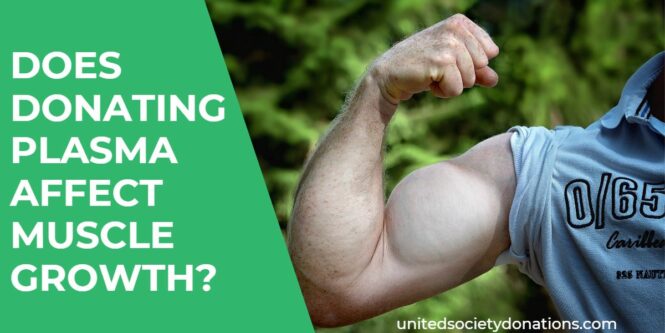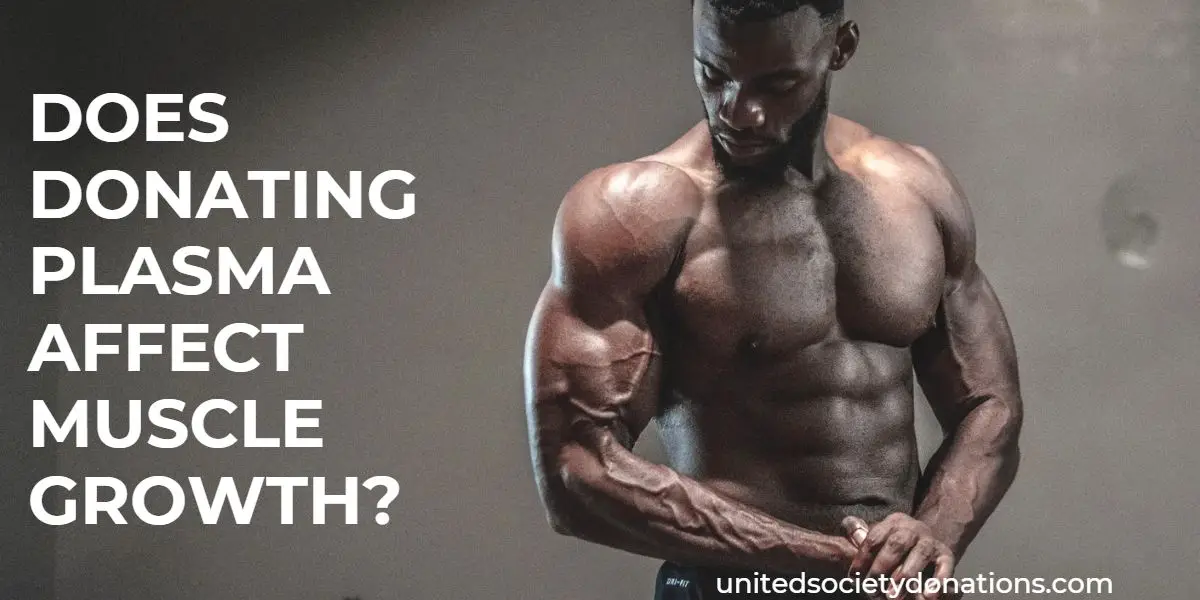
As a regular plasma donor and fitness enthusiast, I have personally wondered, “Does Donating Plasma Affect Muscle Growth”?
So, I conducted thorough research on the topic.
In this article, I share my findings and provide all you need to make an informed decision about balancing plasma donation with your muscle building goals.
Does Donating Plasma Affect Muscle Growth?

Donating plasma can affect muscle growth by potentially leading to decreased iron levels, fatigue, weakness, and reduced platelet count. It is important to balance plasma donation with proper recovery time, nutrition, and exercise to minimize these effects and maintain muscle mass.
If you donate plasma for money, you might be interested in knowing about the CSL Plasma 1000 Bonus.
How Does Donating Plasma Affect Muscle Growth?
Before diving into how does Donating Plasma Affect Muscle Growth, let’s discuss what plasma donations entail. Plasma is a vital part of blood because it contains necessary proteins that can help treat conditions such as hemophilia and clotting factors for burn victims.
During the donation process, your blood passes through an automated system where only the plasma portion remains; this allows your body to retain all other essential components like red and white cells.
After your donation, your body starts working to replenish its volume by shifting body fluids around so that all areas in need receive fresh water and electrolytes like sodium and potassium.
As levels return to normal and new red blood cells start to form again, you may experience symptoms such as fatigue or dizziness – while these could be attributed directly to getting back on your feet after lying down during the donation, your body is just recovering itself at this point with no lasting effect on muscle growth or strength.
The evidence suggests then that donating plasma does not have any significant effect on muscle growth. While there are certain nutrients depleted from our bodies during plasmapheresis (the entire process of donations), replenishment typically happens quickly so long as sound nutrition practices also occur outside of donations.
All in all, when done safely with regular hydration and nutrient regeneration, those looking for aerobic fitness or strength gains should not be concerned about the effect their cellular contribution might have on their fitness journeys!
Kedplasma pays good compensation for plasma donations, so check out Kedplasma New Donor Pay.
The Science behind Plasma Donation and Muscle Growth
Donating plasma can help people in need of its life saving properties, but can it negatively affect muscle growth? The answer is a bit of a grey area due to the lack of scientific evidence on both sides.
On the one hand, there is research that suggests donating plasma might be helpful for some muscle building goals, while there are also studies suggesting the practice could lead to nutrient deficiencies and less energy for workouts.
The main concern with donating plasma is protein metabolism, which is considered the cornerstone for muscle growth. During a donation session, large levels of proteins break down, which can decrease energy stores.
This requires the body to take nutrients from other sources like iron levels and essential amino acids since protein synthesis requires more than just proteins to properly function.
On the other hand, donating plasma can potentially provide a useful source of macronutrient replenishment as it induces anabolic processes (like increased red blood cell production).
Red blood cells carry oxygen and amino acids through your body, which enable quick recovery after training sessions – essentially allowing you to take fewer rest periods between sets or have more reps available during workouts.
Donating plasma should not be taken lightly since it has associated risks that may outweigh potential benefits.
Ultimately, it all comes down to what one seeks from their weight training sessions since frequent donations might not be suitable for those who want lean muscle development or maximal performance results over short period timespans.
Consult medical advice before making any decisions if you’re curious about this topic.
Potential Risks of Donating Plasma Frequently on Muscle Growth
Donating plasma is often seen as a way to gain additional money, but it’s important to consider the potential long-term effects of frequent donations on muscle growth.
Although most people experience no adverse effects from donating their plasma, a few people may experience some rare side effects that could be damaging to their muscles.
The first risk associated with donating plasma too frequently is anemia. Anemia occurs when the donor loses too much iron in regular donations, and their bodies can no longer adequately produce red blood cells, which are needed for transporting oxygen throughout the body.
When left untreated, anemia can cause severe fatigue and weakness, greatly reducing your performance in the gym and leading to decreased muscle growth.
Check out our detailed article on Is It Safe to Donate Plasma Twice a Week.
A second risk of frequent plasma donations is a reduced platelet count (PC), which increases your risk of bleeding easily when cuts occur and decreases your ability to heal them adequately.
A low PC indicates that there are not enough platelets present in your bloodstream, which are vital for clotting when injured.
This means more time spent off workouts due to healing injuries rather than working on those muscles you just paid money for!
Finally, there may be long-term effects from donating plasma that has yet to be discovered, and researchers are still investigating these possible risks so it’s important to proceed with caution when deciding how often you should donate your plasma.
Make sure to research thoroughly before signing up as a frequent donor so you can make an informed decision about what’s best for you and your bodybuilding goals!
How to Balance Plasma Donation and Muscle Growth
Donating plasma is a great way to help save lives and make money, but it’s important to understand how it can impact muscle growth. Donating plasma requires that your body produces new cells, which takes away from the energy stores you need for muscle growth.
To ensure that donating plasma does not affect your muscle growth, it’s important to take a few extra steps:
- Always make sure that you give yourself proper recovery time after making a donation. Plasma centers will generally forbid you from donating more than twice in seven days, so allow at least 24 hours between donations and resistance training workouts or other physically demanding activities.
- Nutrition is key when it comes to maintaining energy stores for workouts and muscle growth. Make sure that your diet has enough protein and healthy carbs to provide adequate fuel for working out and building muscle. Also, be sure to get enough water throughout the day; dehydration can cause low energy levels, just as surely as poor nutrition can.
- Focus on exercises that allow for adequate recovery between workouts. Avoiding overly intense exercises helps protect against overtraining during plasma donation times; this also helps take pressure off of newly forming cells as your body recovers from the donation process itself.
- If you have any concerns about donating plasma and its effect on your muscle growth, consult with your doctor ahead of time to discuss any concerns or questions you may have. Guidelines are generally quite strict with regard to the frequency of donations; however, if anything changes on the part of the centre or if there are new developments regarding their donor criteria, make sure to check in with them regularly too!
The Impact of Plasma Donation on Protein Metabolism and Muscle Growth
Doing protein donation does come with some potential risks that could affect muscle growth. Usually, the plasma collected for donation is removed from the donor’s own body, so there is no risk of acquiring a virus or other disease through the process. But there are some things to consider with regard to muscle growth.
The plasma donation process removes nutrients that can impact muscle health and recovery, including iron and albumin.
Iron levels in particular are important because they help provide red blood cells with oxygen, which is essential for proper muscle recovery after a workout. Low iron levels in athletes can result in reduced performance and weaker muscles.
Albumin is another essential protein for maintaining healthy muscles and post-workout recovery; it serves as a transporter for other proteins around the body, including those needed for muscle synthesis and repair after exercise.
Additionally, human albumin also helps regulate metabolic processes, such as amino acid uptake into tissues as well as enzyme and hormone activity throughout the body – both of which can have an impact on muscle synthesis and growth.
Therefore it’s important that any athlete considering donating plasma take steps to maintain their nutrient status following donations by making sure they eat correctly afterward to replenish lost nutrients.
- Increasing dietary intake of iron-rich foods like lean red meats or dark leafy greens like spinach can be especially beneficial in this instance, or supplementing with an iron tablet may be needed if dietary sources are not enough.
- It is also advisable that athletes aiming to increase their lean mass take care to consume adequate amounts of protein regularly, which should help ensure your body remains in an anabolic state conducive to optimal muscle growth.
If you are interested in donating plasma to a reputable center, check out this article about Grifols Plasma Pay Chart 2024.
FAQs on Does Donating Plasma Affect Muscle Growth
These are the frequently asked questions on Does Donating Plasma Affect Muscle Growth:
Can donating plasma lead to muscle loss?
Direct muscle loss due to plasma donation is unlikely.
Can donating plasma affect my energy levels for workouts?
Some donors may experience temporary fatigue or decreased energy levels after donation.
Conclusion and Recommendations
Donating plasma is generally a safe process as long as it is done as infrequently as possible and within the guidelines set by the American Red Cross, with weight and health being the top priority.
The short answer on Does Donating Plasma Affect Muscle Growth, relies heavily on a person’s overall state of well-being. If their body weight, strength, diet, and exercise regimen are already in balance, then it should not interfere with muscle growth whatsoever – no matter how often they donate. However, if these areas fall out of balance, then it can be difficult to regain that momentum in spite of frequent donations.
Therefore, we highly recommend that before you begin donating plasma, you consult your doctor so they can provide recommendations on what frequency would be most beneficial for your health based on your specific needs and lifestyle habits whilst ensuring that donating does not interfere with regular goals such as maintaining healthy body weight and/or engaging in sports or other physical activities.

